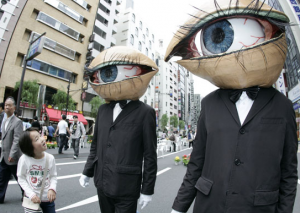The Flaneur Abroad ( Nottingham, 6-7 Jul 12)
University of Nottingham, UK, July 6 – 07, 2012
Deadline: Dec 30, 2011
 The Flâneur Abroad: nternational and historical perspectives on an urban archetype
The Flâneur Abroad: nternational and historical perspectives on an urban archetype
A conference organised through the collaboration of the Nottingham
Institute for Research in Visual Culture, and the Urban Culture Network
at the University of Nottingham
Friday 6-Saturday 7 July 2012
CALL FOR PAPERS
The flâneur – the leisurely but vigilant urban stroller – is well-known as a quintessential nineteenth-century Parisian archetype, and has attracted a distiguished array of champions and historians – from Balzac and Baudelaire to Walter Benjamin. However, although recent
writing on the subject (The Flâneur, ed. Keith Tester, and The Invisible Flâneuse, ed. Tom Macdonough, Aruna d’Souza) have certainly been eclectic in their scope, there has been little sustained attention given to the adaptation of the phenomenon outside Paris, let alone outside France and indeed Europe, whether in the form of modern sequels, contemporary echoes, as well as historic antecedents.
The flâneur as self-contained but all-seeing city-dweller has been seen as an icon of modernity, tyrant of the empowered male gaze, and anguished urbanite in retreat from the inhospitable environment of the city and its threatening crowds. Within Paris its meanings evolved from early nineteenth-century versions, including alienated consumers and
voracious voyeurs, to more second-order types of pedestrian observer, as in the case of self-indulgent touristic fantasies. Yet the allure of the flâneur’s persona has led to its translation far beyond Parisian boulevards and arcades. This conference aims to map some of the flâneur’s travels and transpositions. In doing so, it may be possible to clarify how far the flâneur is dependent on Paris as a milieu. And in historical terms, is it in fact a variant form of older, more inclusive patterns of walking, viewing and writing the city? Can we find models and antecedents for pedestrian spectators in earlier ages and locations? When modern flâneurs step out in foreign cities, how much of a Parisian ethos clings to them? How limiting is the flâneur’s gaze and mind set? This might also apply to Parisians (or adopted Parisians) travelling abroad, or francophile pedestrians.The flâneur’s afterlife has been versatile and vigorous. In addition to the well-established genre of novels of the city, new media of photography, film and TV have successively adopted the peripatetic as a mode of vision. When the modern flâneur has migrated into other media, how has this reinforced or reinvented the motif?
The conference is intended to be interdisciplinary, bringing together scholars from art history, history, literary studies, film, history of photography, music, historical and cultural geography. Research students are encouraged to offer work in progress papers.
The keynote to the conference is geographical and temporal diversity; however, papers related to the following topics would be welcome:
• Pedestrian spectators in the metropolis: Berlin, Madrid, Naples, St Petersburg, New York, Los Angeles…
Papers on Asian and African sites are especially welcome – Cairo, Damascus, Istanbul, Beijing, Tokyo…
• The artist as flâneur / flânerie as art
• Musical forms of expression which invoke flâneurie, and related forms of living in the city.
• The mobile spectator as critic, iconoclast
• The flâneur as role model for Situationism
• Idlers, flâneurs, observers, spectators in journalism
• Flânerie as dérive / dérive as flânerie
• Last but not least, variants on or revisions of the stereotype of the flâneur in Paris (at any period).
Please send proposals (c.250 words) by December 30th 2011 to:
Richard Wrigley, Department of Art History, School of Humanities,
University Park, University of Nottingham, Nottingham NG7 2RD
richard.wrigley@nottingham.ac.uk
Reference :http://arthist.net/archive/2263

Leave a Reply
You must be logged in to post a comment.